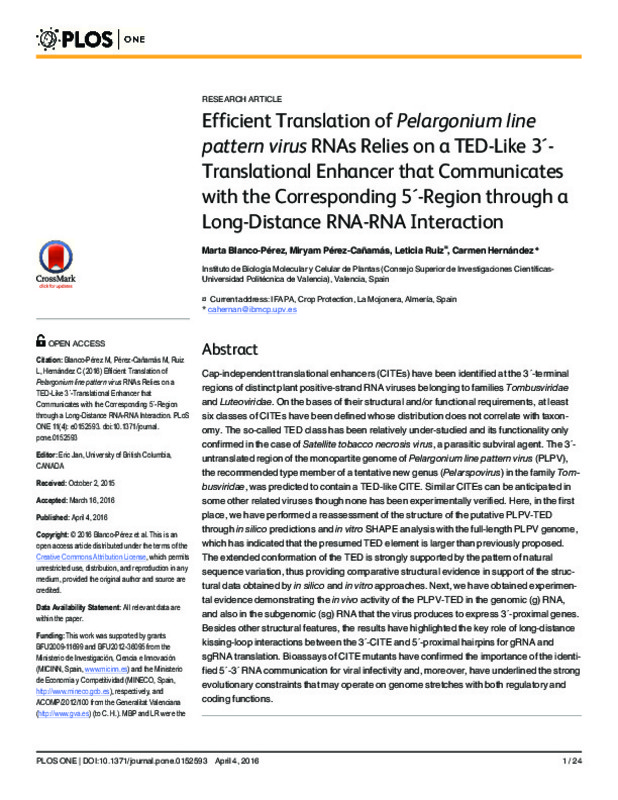JavaScript is disabled for your browser. Some features of this site may not work without it.
Buscar en RiuNet
Listar
Mi cuenta
Estadísticas
Ayuda RiuNet
Admin. UPV
Efficient Translation of Pelargonium line pattern virus RNAs Relies on a TED-Like 3 '-Translational Enhancer that Communicates with the Corresponding 5 '-Region through a Long-Distance RNA-RNA Interaction
Mostrar el registro sencillo del ítem
Ficheros en el ítem
| dc.contributor.author | Blanco Pérez, Marta
|
es_ES |
| dc.contributor.author | Pérez Cañamás, Miryam
|
es_ES |
| dc.contributor.author | Ruiz, Leticia
|
es_ES |
| dc.contributor.author | Hernandez Fort, Carmen
|
es_ES |
| dc.date.accessioned | 2017-06-26T07:41:36Z | |
| dc.date.available | 2017-06-26T07:41:36Z | |
| dc.date.issued | 2016-04-04 | |
| dc.identifier.issn | 1932-6203 | |
| dc.identifier.uri | http://hdl.handle.net/10251/83590 | |
| dc.description.abstract | [EN] Cap-independent translational enhancers (CITEs) have been identified at the 3'-terminal regions of distinct plant positive-strand RNA viruses belonging to families Tombusviridae and Luteoviridae. On the bases of their structural and/or functional requirements, at least six classes of CITEs have been defined whose distribution does not correlate with taxonomy. The so-called TED class has been relatively under-studied and its functionality only confirmed in the case of Satellite tobacco necrosis virus, a parasitic subviral agent. The 3' untranslated region of the monopartite genome of Pelargonium line pattern virus (PLPV), the recommended type member of a tentative new genus (Pelarspovirus) in the family Tombusviridae, was predicted to contain a TED-like CITE. Similar CITEs can be anticipated in some other related viruses though none has been experimentally verified. Here, in the first place, we have performed a reassessment of the structure of the putative PLPV-TED through in silico predictions and in vitro SHAPE analysis with the full-length PLPV genome, which has indicated that the presumed TED element is larger than previously proposed. The extended conformation of the TED is strongly supported by the pattern of natural sequence variation, thus providing comparative structural evidence in support of the structural data obtained by in silico and in vitro approaches. Next, we have obtained experimental evidence demonstrating the in vivo activity of the PLPV-TED in the genomic (g) RNA, and also in the subgenomic (sg) RNA that the virus produces to express 3'-proximal genes. Besides other structural features, the results have highlighted the key role of long-distance kissing-loop interactions between the 3'-CITE and 5'-proximal hairpins for gRNA and sgRNA translation. Bioassays of CITE mutants have confirmed the importance of the identified 5'-3' RNA communication for viral infectivity and, moreover, have underlined the strong evolutionary constraints that may operate on genome stretches with both regulatory and coding functions. | es_ES |
| dc.description.sponsorship | This work was supported by grants BFU2009-11699 and BFU2012-36095 from the Ministerio de Investigacion, Ciencia e Innovacion (MICINN, Spain, www.micinn.es) and the Ministerio de Economia y Competitividad (MINECO, Spain, http://www.mineco.gob.es), respectively, and ACOMP/2012/100 from the Generalitat Valenciana (http://www.gva.es) (to C.H.). MBP and LR were the recipients of a predoctoral and postdoctoral (Juan de la Cierva program) contract, respectively, from MICINN, and MPC was the recipient of a predoctoral contract from MINECO. | en_EN |
| dc.language | Inglés | es_ES |
| dc.publisher | Public Library of Science | es_ES |
| dc.relation.ispartof | PLoS ONE | es_ES |
| dc.rights | Reconocimiento (by) | es_ES |
| dc.subject | CAP independent translation | es_ES |
| dc.subject | Tobacco necrosis virus | es_ES |
| dc.subject | Plant viral RNAs | es_ES |
| dc.subject | Satellite tobacco | es_ES |
| dc.subject | Messenger-RNA | es_ES |
| dc.subject | Untranslated regions | es_ES |
| dc.subject | Family Tombusviridae | es_ES |
| dc.subject | Genome organization | es_ES |
| dc.subject | Loop interactions | es_ES |
| dc.subject | Stem loop | es_ES |
| dc.title | Efficient Translation of Pelargonium line pattern virus RNAs Relies on a TED-Like 3 '-Translational Enhancer that Communicates with the Corresponding 5 '-Region through a Long-Distance RNA-RNA Interaction | es_ES |
| dc.type | Artículo | es_ES |
| dc.identifier.doi | 10.1371/journal.pone.0152593 | |
| dc.relation.projectID | info:eu-repo/grantAgreement/MICINN//BFU2009-11699/ES/Estudio De Mecanismos De Traduccion No Canonicos En Virus De Plantas: Analisis De Las Posibles Ventajas De Su Utilizacion Frente Al Mecanismo Convencional/ | es_ES |
| dc.relation.projectID | info:eu-repo/grantAgreement/MINECO//BFU2012-36095/ES/ANALISIS DE UNA RELACION COMENSALISTA VIRUS-PLANTA: ESTUDIO DE DETERMINANTES DE ACUMULACION VIRAL Y DE POSIBLES ALTERACIONES EPIGENETICAS EN EL GENOMA DEL HUESPED/ | es_ES |
| dc.relation.projectID | info:eu-repo/grantAgreement/GVA//ACOMP%2F2012%2F100/ | es_ES |
| dc.rights.accessRights | Abierto | es_ES |
| dc.contributor.affiliation | Universitat Politècnica de València. Instituto Universitario Mixto de Biología Molecular y Celular de Plantas - Institut Universitari Mixt de Biologia Molecular i Cel·lular de Plantes | es_ES |
| dc.description.bibliographicCitation | Blanco Pérez, M.; Pérez Cañamás, M.; Ruiz, L.; Hernandez Fort, C. (2016). Efficient Translation of Pelargonium line pattern virus RNAs Relies on a TED-Like 3 '-Translational Enhancer that Communicates with the Corresponding 5 '-Region through a Long-Distance RNA-RNA Interaction. PLoS ONE. 11(4):1-24. https://doi.org/10.1371/journal.pone.0152593 | es_ES |
| dc.description.accrualMethod | S | es_ES |
| dc.relation.publisherversion | http://doi.org/10.1371/journal.pone.0152593 | es_ES |
| dc.description.upvformatpinicio | 1 | es_ES |
| dc.description.upvformatpfin | 24 | es_ES |
| dc.type.version | info:eu-repo/semantics/publishedVersion | es_ES |
| dc.description.volume | 11 | es_ES |
| dc.description.issue | 4 | es_ES |
| dc.relation.senia | 331718 | es_ES |
| dc.identifier.pmid | 27043436 | en_EN |
| dc.identifier.pmcid | PMC4820102 | |
| dc.contributor.funder | Ministerio de Ciencia e Innovación | es_ES |
| dc.contributor.funder | Ministerio de Economía y Competitividad | es_ES |
| dc.contributor.funder | Generalitat Valenciana | es_ES |








